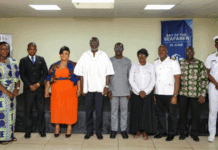The Kwahu State Book is arguably the biggest and detailed history book in Ghana and Sub-Saharan Africa. Kwahu State Book was undertaken by the office of the Ghana State Book Project in collaboration with the Kwahu traditional Council and the Daasebre Development Advisory Board. An exercise that took more than three (3) years, engaged over five thousand (5,000) people from six hundred and fifteen (615) communities who availed themselves to present oral history about Kwahu.
The team retrieved over 20,000 pages of documents that were relevant about the history and traditions of Kwahu. These documents were retrieved from Libraries, archives, courts including foreign archives and libraries in London, Netherlands and Portugal. The general public was given the opportunity in an exhibition exercise to participate in the Kwahu State Book documentation.
Finally, a Review Committee was established to address all queries forwarded by members of the various families. After the exercise, three hundred and twenty-five (325) people from the leadership of all the royal families in Kwahu signed declaration to authenticate the history captured in the book.
The book tries to compile historical records of pre-Kwahu settlements dating into the aged centuries. Ghana State Book Project has researched into the archaeological reports in addition to oral and written records of how Kwahu used to be; dating into the past years, long before Christ was born (BC).
The research lens embraces archaeological findings of Bosumpra Rocks located in Abetifi by Professor Thurstan Shaw in 1944 and all the other findings afterwards. The book tries to link ancient settlements like the “Ayewa Dwaso” in Abetifi, “Bosumpra”, “Atala pie”, “Anweaso”, “Apem Anim” and other ancient settlements of Kwahu to the original Kingdom of the Guan people believed to be the first settlers of Ghana. Hence, the findings throw more light on other ancient kingdoms like the Bono Kingdom to help draw inferences to lay a good foundation for determining traces of migration of the Kwahu people.
The scope of the Kwawu State Book also tries to examine other research and archaeological findings on some notable areas like the Bruku Rock, Oworobong Atifi, the Bankame Stone, the Alligator Rock, the Rock of Kotoso, the Amartey Rock, the Opambour Cave, the Gaping Rock, Oworobong Waterfalls, etc. In all these, efforts were made to unravel hidden historical records about the ancient settlements of pre-Kwahu era. The book deeply explains what Kwahu used to be before the emergence of the present Kwahu.
The book also makes conscious efforts to unveil the various settlements of Kwahu in the early historical periods that follow the stone age era. A connection is established to explain the settlements and dynastic rule of Ganeboafo and Juafo Abotan. This section of the Kwahu State Book also investigates and examines in details the migration and settlement of Adamu Yanko group, Bransem Diawuo group, Odiaboa group, Kosa Brempon group and Yaw Awere group.
The above migrants are known in both the written and oral traditions of Kwahu histories to be the earlier settlers of Kwahu. At this stage, the book unveils in details the arrival of the Osei Twum entourage (Bukuruwa) and their connection to the Akyem Kotoku people.
Attempts are made in the book to connect Kwahu at the time to Adanse and Denkyira empires to help draw extrapolations that could lay the foundation for further studies. It is believed that the essence of exploiting and fighting for one’s authoritative existence was realized during this era, hence, the first phrase, “nkɔ nko wu” or “nkɔhɔ nko wu”, literally meaning, “don’t go there and die” which marked the foundation of the name, Kɔwu, was coined to depict the danger that existed in those terrains of settlements at the time. This became reflective in the map of Gold Coast in 1629 by the Dutch when some settlements of Kwahu were identified as radical.
The book presents the foundation of the current Kwahu and how the earlier settlers exhibited their independent superiorities before subsequently gelling to accommodate each other. Symbolically, one could say this was the period when Kwahu was conceived. The arrival of the Etena-Bretuo-Asona entourage led by Eson Gyema in the 17th Century marked the beginning of the current Kwahu.
The book again highlights how people migrated in groups to settle in the present Kwahu in the 17th and 18th Centuries. The book traces the migration and settlement of the Etena -Bretuo-Asona crystal of royals that migrated from Adanse.
The detailed examination of their migration conveys distinctive histories of Abene, Abetifi, Twenedurase, Aduamoa, Nteso, Pepease and Nkwatia. It again traces the migration and settlements of historical enclaves like Pitiko (Okoambre Aduana royals) and the Ankaase people.
The book again delves into the oral traditions of other traditional states to help establish the roots and traditional linkages of the Kwahu communities. It further explains in detail the emergence and migration of some notable communities in Kwahu like Obo, Obomeng, Bepong, Asakraka, Pitiko, Mpraeso, Kwahu Tafo, Atibie, Akwasiho, Nkorkoor (Nkawkaw) just to mention a few.
Other information captured in the book include histories about the various Kwahu associations in Ghana and Abroad, schools, churches, Kwahu personalities, the Zongo Communities in Kwahu, the Okwawu United Football Club and the core festival and traditions of the Kwahu people.
The book acknowledges and exploits findings of some renown researchers like Wallis, Smith, Shaw, Musonda, Ward, Justeson, Van Dantzig, Daaku, Olfert Dapper, Wolfson, Kyeremanteng, Ameyaw, Arhin, Metcalife, Anquandah and many others.
Writers
>>>the Project Coordinator, Ghana State Book Project
>>>Secretary, Daasebre Dev’t Advisory Board- Kwahu State










